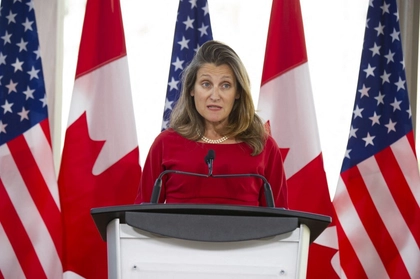The Ukrainian Air Force (UAF) is finally able to support Kyiv’s ground offensive in Kursk Oblast. On Aug. 16, Lt. Gen. Mykola Oleshchuk, the UAF Commander, said, “The Air Force's aviation actively participates in the hostilities on the Kursk front. Ukrainian pilots used high-precision strikes to target enemy strongholds, clusters of equipment, logistics centers, and hostile supply routes.”
On Aug. 13 t, videos appeared online showing a Ukrainian SU-27 dropping a US-made Joint Direct Attack Munition (JDAM) glide bombs at a Russian command post and hangar in Tetkino, a few kilometers north of the front line in Kursk.
JOIN US ON TELEGRAM
Follow our coverage of the war on the @Kyivpost_official.
The Ukrainian Air Force was also involved in the destruction of at least one of the three bridges over the Seym River, effectively trapping around 700-800 Russian paratroopers.
On Aug. 20, a video of a Ukrainian fighter aircraft striking an underground Russian command post in Kursk direction with a French “Armement Air-Sol Modulaire” (AASM) Hammer GPS-guided bomb was posted.
The maximum range of the AASM is around 50 kilometers (32 miles) with a high-altitude launch and 15 kilometers (10 miles) with a low-altitude launch.The JDAM-Extended Range (JDAM-ER) has a range of about 72 kilometers (45 miles). Consequently, both JDAM and AASM have to be delivered well within the range of Russian ground-based and air-launched air defense systems.

Canada’s Chrystia Freeland – A Personal View
According to Forbes, “The risk to aircraft around the Kursk salient is significant. The Ukrainian military deployed what one Russian blogger characterized as “a significant numbert” of air-defense batteries as well as electronic jammers that can block radio signals and, in some cases, even throw off satellite-guided bombs.”
Russian vulnerabilities
Normally, Russian air defense and combat aircraft would be expected to maintain air superiority over Russia and parts of Ukraine.
The air strikes, however, suggest that Ukrainian combat aircraft are able to operate more freely than expected. The fact that it is allowed to deliver bombs against a high-value target on Russian territory suggests that Russia lacks:
- Sufficient Air Surveillance and Airborne Early Warning assets to counter Ukrainian strike missions effectively.
- The ability to mount standing Combat Air Patrols (CAP) needed to intercept Ukraine fighter jets before they can lob bombs against targets beyond the frontline, and
- A sufficient air defense network capable of defending key objects against Ukrainian air strikes delivered by combat aircraft, missiles and drones.
This follows a Ukrainian campaign that targeted radars, air bases, air defense units and electronic warfare systems, as well as fuel and ammunition depots in Russia. In the process, it has not only crossed declared Russian red lines but also managed to shape the battlefield to its advantage.
Targeting Russian AEW&C assets
Ukraine's air force has shot down two of Russia's Beriev A-50 airborne early warning and command (AEW&C) aircraft and damaged one Airborne Command Post (Il-22M), all crucial to establishing a clear picture of the air space and exercising command and control over the battlefield.
A third A-50 was struck by drones near the Machulishchy airbase in February 2023. Ukraine also launched a drone strike against a factory used to refurbish the aircraft in the southern Russian city of Taganrog. Ironically, a second Il-22M was downed by Russia’s own Wagner group on June 24, 2023.
Of the six A-50s that are believed to remain, it is unclear how many if any remain operational. The Ukrainian strikes inside Russia indicate the answer to be: “Too few”.
Targeting Russian Air Defense
On Oct. 4, 2023, a Russian S-400 air defense system was reportedly destroyed by Ukrainian drones near Belgorod. On June 3, 2024, a Russian S-300/400 air defense system was destroyed by HIMARS rockets in Belgorod. These come on top of the many S-300, S-350, S-400 and S-500 launchers destroyed or damaged in Crimea, forcing Russia to disperse its declining number of air defense systems along an increasingly longer and more vulnerable front line.
Russia has also shown itself unable to stop the many Ukrainian drone strikes targeting key defense, industrial and logistic objectives. On April 3 ISW reported that the “Republic of Tatarstan Head Rustam Minnikhanov warned that Russian companies and local authorities must defend themselves against Ukrainian drone strikes and not rely on Russian air defenses […].
“Minnikhanov’s statement is likely a reflection of increased Russian concern […] and is a clear acknowledgement and admonition of the Russian Ministry of Defence’s (MoD) failure to defend Russian cities and critical infrastructure from Ukrainian drone strikes.”
As of July 16, Ukrainian forces claimed to have destroyed 20 S-300/S-350/S-400 and S-500 launchers and 15 radar stations in Russia. It has since destroyed four more. It has damaged or destroyed more than 920 air defense means since the start of the full-scale war.
Targeting Russian Air Power
According to the Ukrainian General Staff, Ukraine has until now destroyed 367 Russian aircraft and 328 helicopters since the start of the full-scale war.
Most Western commentators, however, indicate lower numbers. “We do not see significant losses in the air domain, especially their long-range and strategic aviation fleets,” Army Gen. Christopher G. Cavoli, the head of the US European Command and NATO’s Supreme Allied Commander, said during a House Armed Services Committee hearing in April 2024.
“The air force has lost some aircraft, but only about 10 percent of their fleet,” Cavoli added in his written testimony to the committee.”
The fact remains, however, that Russia has failed to establish control of the air space over Ukraine and has not operated combat aircraft over Ukrainian-controlled territories since the spring of 2022 due to high losses. Ukraine’s ability to provide air support to its ground operations in Kursk underlines Russia’s shortcomings.
Kyiv has also deployed both conventional and unconventional air defense units to Kursk. Until now, it has shot down a Russian Su-34. More impressively, in what is probably the first time in history that first-person-view (FPV) drones successfully attacked a helicopter in the air. A Russian Mi-28 attack helicopter was reportedly hit in Kursk Oblast on Aug 6, while three days later, the Security Service of Ukraine (SBU) claims to have also hit a Russian Mi-8 in mid-air with a FPV drone.
Targeting Russian Air bases
Ukraine has persistently attacked Russian Air Bases, forcing it to relocate its combat aircraft to airfields further away from the frontline. Ukrainian long-range drones reportedly struck four airbases overnight on Aug, 14 in what is believed to be the largest attack on Russian airfields in the war.
That was the latest in a series of strikes, which included the Lipetsk air base on Aug. 9, the Olenya, Engels and Dyagilevo air bases on July 27, the Millerovo air base on July 20, the Akhtubinsk air base on June 6, the Morozovsk air base on June 14, and the Morozovsk air base on April 5. The attacks were aimed at reducing Russia’s ability to uphold air control, support ground operations and strike Ukrainian infrastructure, cities and villages.
The presence of ATACMS alone has impacted Russian air power. It caused an initial shock when used against Russian airfields on occupied territories, forcing Russia to relocate combat aircraft and helicopters at greater distances.
Unfortunately, according to ISW’s Nataliya Bugayova, the US continues to debate restrictions on Ukraine’s use of US weapons which gives “the Kremlin time to insulate Russia from damage. Russia redeployed air assets in the range of ATACMS to airbases further away from Ukraine to protect them against a potential US policy change for Ukraine.”
So what?
Ukraine has over time both exposed as well as increased Russian Air Power vulnerabilities. It has not only denied Russia air superiority over Ukraine but also challenged its ability to control the Russian airspace. At least 10 per cent of its fleet has been destroyed. Its AEW&C platforms have been reduced. Its air defense network is being depleted. It is forced to relocate its combat aircraft and helicopters further away from the front line. Its ammunition and fuel depots are being targeted and when possible, demolished.
Outnumbered and outgunned in the skies, Ukraine has used surface-to-air missiles to keep Russian aircraft at arm’s length. The introduction of F-16s over the battlefield, however, will further reduce Russia’s advantages in the air and on the ground.
While many tend to compare the F-16 with modern Russian combat aircraft, the actual point of reference is Ukraine’s present fleet of fighter jets. It has worked wonders with Soviet-legacy, low-tech combat aircraft. Imagine what it can achieve with US-made, fourth generation fighters carrying high-tech sensors, weapons and communications suites.
The F-16 is not only far more modern, more pilot-friendly, and capable of carrying more weapons, the F-16 is also equipped with a more powerful radar system.”
US Air Force Lt. Col. Dan Hampton (retired) argued that the Russian Su-35s lack the advanced radar systems fitted into F-16s, resulting in the Russian aircraft being “easy to see, easy to pick up on radar, and easy to shoot at with a long-range missile.” Even more so when supported by the Swedish donated Saab 340 airborne early warning aircraft equipped with Link 16 datalinks, allowing them to share a real-time accurate air picture with Ukraine’s F-16s.
The F-16 will slowly help improve the situation in the air and on the ground. Firstly, by filling the gaps left by the ground-based air defense systems. Secondly, by intercepting Russian fighter jets before they can drop their guided glide bombs. Thirdly, by providing direct support to Ukrainian ground forces.
Ukrainian combat aircraft operations in direct support of the Kursk incursion demonstrate that the F-16 – once received in sufficient numbers and properly manned at all levels – will help to further erode Russia’s Air Power.
Recruiting foreign pilots and technicians would greatly help speed up the transformation.
The views expressed in this opinion article are the author’s and not necessarily those of Kyiv Post.
You can also highlight the text and press Ctrl + Enter






